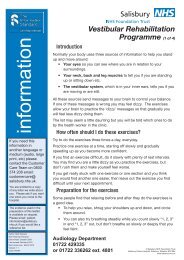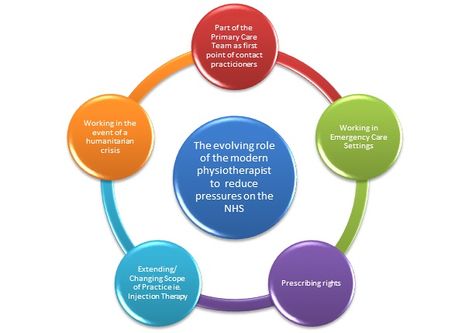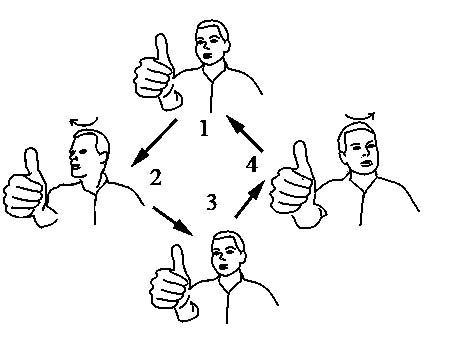vestibular rehab exercises pdf nhs
Exercises A In bed 1 Eye movements. L All exercises should be performed slowly to begin with and gradually progress to faster movements.

Vestibular Neuronitis Vestibular Neuritis Conditioner Inner Ear
General Information for Eye Exercises Target must remain in focus not blurry and appear stationary while head is in motion.

. Keeping the head still move eyes up and down 2. Evidence has shown that vestibular rehabilitation can be effective in improving symptoms related to many vestibular - inner ear - disorders. Eye and head movement exercises.
Position tilt head down 30º. You may find it helpful to complete your exercises at specific times each day. Extra Vestibular Rehabilitation Exercises Procedure Make sure you are seated safely before starting the exercises.
To enable this to work fully you will need to be dedicated to doing exercises regularly through. Progress can be fast or slow and it may be 1-2 months before you notice the improvement. Turn your head about half way 45 degrees to the Right.
We recommend that you complete your exercises three times a day if possible. Exercises manoeuvres suitable for self management of positional vertigo. It is important to complete your exercises this often every day.
Vestibular Rehabilitation Brandt-Daroff Habituation Exercise. Vestibular rehabilitation exercises This is a specific form of physiotherapy which may be suggested if your movements are very affected. Following a thorough examination a specialist Physiotherapist will develop a personalised home exercise programme for you.
Speed of eye movement should be increased as long as the target stays in focus. Exercises to improve standing. Treatment may also include increasing.
How difficult should my exercises feel. Vestibular rehabilitation exercises A fact sheet for patients and carers Vestibular compensation Vestibular compensation is a process that allows the brain to regain balance control and minimise dizziness symptoms when there is damage to or an imbalance between the right and left vestibular organs balance organs in the inner ear. Turn your head from right to.
Cawthorne-Cooksey Vestibular Exercises Section A. Focus on your index finger as you bring it from arms length away up to your nose then out again. Quickly lie down onto your Leftside.
Some of the exercises might not provoke dizziness. The basic exercises for dizziness. Repeat times per session.
Be careful when you start to move after you have completed the exercises. Following thorough examination your Audiologist will work with you on a management plan that may include exercises that you can do at home. Vestibular Rehabilitation Exercises Level 1.
Should an exercise make you feel off balance dizzy or unstable practice this exercise for the remainder of the. Keeping head still move eyes left to right 3. These exercises are designed to allow your vestibular system to compensate in a.
The brain interprets information gained from the vestibular or balance system. Within the vestibular or balance system. If you use glasses wear them while performing exercises.
At first slow then quick a up and down b from side to side c focus on finger moving from 3ft to 1ft away from face 2 Head movements. Begin with exercise 1. You should perform the exercises daily for maximal benefit.
At first slow then quick. Exercises l Make sure that you are in a safe environment before you start any of the exercises to reduce the risk of injury. Vestibular Rehabilitation Exercises Level 2.
If symptoms become too severe take a break. As they are designed to challenge your balance system you may feel some. If there is no dizziness lie on your side for 30 seconds.
Exercises for long-term balance problems. It helps to retrain the brains ability to adjust the balance problem and is known as compensation and adaption. C Focus on fingers at arms length.
Stay on the Leftside until your dizziness goes away PLUS 30 seconds. Exercises to improve standing balance. Level 1 Eye movements head kept still a Look up then down.
When there is an injury or abnormality in any portion of this system the brain must be retrained or taught to interpret correctly the information it receives. Sitting first then when more confident standing. Vestibular exercises merely stimulate the vestibular apparatus.
Do sessions per day. Vestibular assessment and typing up documentation Patient Patient knowledge ability to give a good history present symptoms ability to cope with assessment support system Log of symptoms diary Vestibular rehabilitation Relaxation exercises Patient information leaflets vestibular rehabilitation exercise booklet. L Exercises should be performed 3 times a day.
Vestibular rehab exercises pdf nhs Saturday April 2 2022 Edit. Your vestibular rehabilitation exercises are designed to make you experience mild. Vestibular Rehabilitation is an exercise-based programme to encourage the nervous system to compensate for problems in the inner ear.
Cawthorne-Cooksey Vestibular Exercises Section A. Let symptoms subside plus seconds with each repetition. The management plan may include.
Vestibular rehabilitation wwwuhcwnhsuk - 2 - From this assessment the audiologist will develop an individualised treatment plan that will include exercises to be performed both in the department and at home which combine specific head and body movements with eye exercises. Work your way down the exercises within the 10 minutes. Secondary problems due to vestibular disorders.
It helps to breathe slowly if you feel dizzy no more than one breath every four to six seconds. Vestibular rehabilitation exercises are. Sit on your couch or bed.
VR exercises involve head and eye movements that are. Later with eyes closed. A bend backwards and forwards b turn from side to side B Sitting 1 and 2 - as above.
Vestibular rehabilitation VR is an exercise-based programme that is designed to encourage the central nervous system to compensate for problems in the inner ear. To loosen up before starting gently shrug your shoulders and circle them around a few times. If an exercise does not cause dizziness you should move on to the next exercise.
It is an exercise-based program primarily designed to reduce vertigo and dizziness reduce gaze instability andor reduce imbalance. The management plan may include. Please do all six movements 2-3 times each day.
Vestibular rehabilitation exercises A fact sheet for patients and carers Vestibular compensation Vestibular compensation is a process that allows the brain to regain balance control and minimise dizziness symptoms when there is damage to or an imbalance between the right and left vestibular organs balance organs in the inner ear. Dont worry if you seem to be stuck at an exercise for a week or more. Do not overdo the exercises.
Slowlyquickly move head rightleft with eyes openclosed. During vestibular rehabilitation therapy VRT home exercises are a vital part of treatment.

Vestibular Rehabilitation Giddiness Exercises Youtube

Vestibular Rehabilitation Benefit Questionnaire

Vestibular Rehabilitation Exercises Brain Spine Foundation

Reducing Pressures On The Nhs The Emerging Role Of The Physiotherapist In Healthcare Reform Physiopedia

Wrist Exercises Mobilityexercises Wrist Exercises Hand Therapy Exercises Hand Therapy

Vor Exercise Gaze Stabilisation Exercises Ear Balance And Eustachian Tube

Wrist Exercises Mobilityexercises Wrist Exercises Hand Therapy Exercises Hand Therapy

Pdf Protocol For A Randomised Controlled Feasibility Study Of Psychologically Informed Vestibular Rehabilitation For People With Persistent Dizziness Invest Trial
